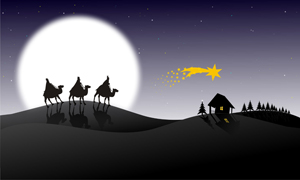
DAVID ADAMS separates some of the Christmas story traditions from what’s recorded in the Bible…
Christmas is coming and so we thought it was timely to take a look at the Christmas story as it’s told in the Bible and separate it from some of the traditions which have grown up around it…

PICTURE: Bartek Ambrozik/www.freeimages.com
• Scholars believe Jesus wasn’t born in the year zero but probably around 4 or 5BC (“Before Christ”) (as a side note, the Gregorian calendar doesn’t actually have a year zero but jumps straight from BC to AD). While we celebrate His birth on 25th December, the exact date of His birth remains something of a mystery. But there’s plenty of speculation based on things such as the idea that shepherds would only normally be out watching over their flock in warmer months between April and October.
• Nativity plays often feature an “innkeeper” who informs Joseph upon his and Mary’s arrival in Bethlehem that there’s “no room at the inn”. But Bethlehem was a small village and unlikely to have an inn of its own. It’s more likely they were unable to find any space usually set aside for guests in a private house (it was already full) and so had to bed down where animals would normally be housed – although none are mentioned in the Biblical account.
• Mary is commonly depicted in stories of the Nativity riding on a donkey. But the Bible doesn’t actually record how she and Joseph made their way from Nazareth to Bethlehem. She may also have been in Bethlehem some time before giving birth to Jesus – Luke simply records the birth as taking place “while they were there” which may mean they arrived some time earlier.
• Jesus is typically understood to have been born in a stable. But the Bible only records that he was “placed in a manger”, a word generally used to refer to a stall or crib for feeding cattle. This could have been located in a stable or cave, and may have been on the ground floor of a home (people generally slept in the “upper room” above this area).
• It’s a popularly held notion that the angels sang after announcing the birth of Christ to the shepherds. But the Bible – in Luke – records that after a single “angel of the Lord” appeared to them announcing the birth, “suddenly a great company of the heavenly host appeared with the angel, praising God and saying, ‘Glory to God in the highest heaven, and on earth peace to those on whom his favor rests'” (Luke 2:13-14; NIV). No singing is recorded.
• “We three Kings of Orient…” So goes the carol of the same name. Except nowhere in the Bible does it say the three “magi” or “wise men” – perhaps astrologers? – were kings. And the only reason they are thought to have numbered three is because of the three gifts – “gold, frankincense and myrrh” – mentioned in Matthew 2. The wise men are also usually shown upon camels – but, again, the Bible doesn’t record their means of transportation – nor does it say where they came from apart from the broad idea of the “east”.
• While we’re on the wise men (whose traditional names Melchior, Caspar and Balthazar are first recorded around 500 AD), it’s believed that they didn’t visit Jesus on the night of his birth but some time later (Fearful of the arrival of this new ‘king’, Herod, in what is generally known as the Massacre of the Innocents, gave orders for all the boys in Bethlehem and its vicinity aged under two to be killed, so Jesus could have been aged anywhere up to two years old at the time of their visit).
• And, so to the star that led them to Jesus. It wasn’t – as is commonly thought – a continuous sign but rather appeared in two distinct sightings – first when it led the wise men to Jerusalem where they met with King Herod – and secondly when it led them to the ‘house’ (not stable) where Jesus was.
You can find the Biblical story of the birth of Jesus in Matthew, chapters 1 to 2, and Luke, chapters 1 to 2.





